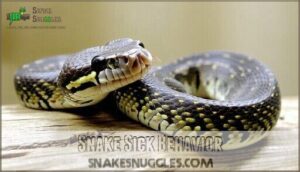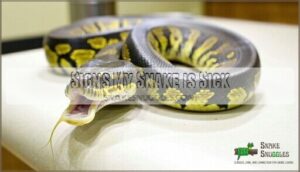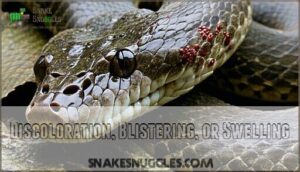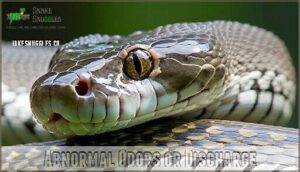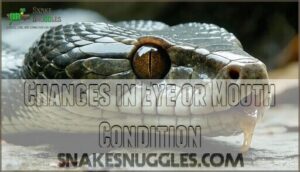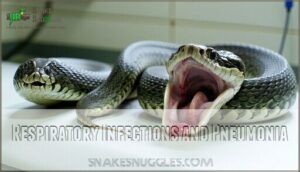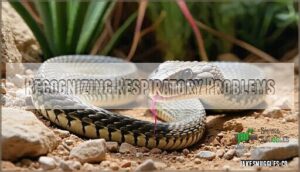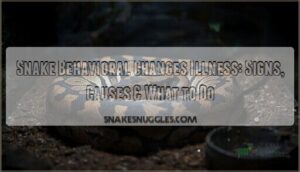This site is supported by our readers. We may earn a commission, at no cost to you, if you purchase through links.

A healthy snake is usually alert and active, so look out for lethargy, loss of appetite, or unusual aggression.
Notice if it’s breathing with its mouth open, wheezing, or has mucus around its nose or mouth—these can signal respiratory issues.
Physical signs like swelling, discolored scales, or sores are red flags, too.
Keep an eye on your snake’s shed cycles and weight; abnormalities there can hint at underlying issues.
Catching problems early can save your slithery friend from getting worse.
Table Of Contents
- Key Takeaways
- Snake Sick Behavior
- Signs My Snake is Sick
- Physical Signs of Illness
- Common Snake Health Issues
- Recognizing Respiratory Problems
- Frequently Asked Questions (FAQs)
- How do snakes act when sick?
- How do I know if my snake is unhealthy?
- What does snake sick look like?
- How do you know if a snake is sick?
- How can one tell if they have shingles without a rash?
- How do you know if a snake has a virus?
- Are snakes sick?
- How can I tell if my snake is sick?
- What are some specific symptoms of common illnesses in snakes?
- Why is shedding a concern for snake health?
- Conclusion
Key Takeaways
- Look out for changes in behavior like lethargy, loss of appetite, or unusual aggression, as these can be early signs of illness.
- Pay attention to physical symptoms like discolored scales, swelling, mucus around the nose, or shedding issues.
- Watch for respiratory problems, including wheezing, open-mouth breathing, or nasal discharge, and adjust humidity and ventilation as needed.
- Observe for signs of external or internal parasites such as mites, weight loss, or unusual skin conditions, and consult a vet if necessary.
Snake Sick Behavior
Knowing how your snake behaves when healthy helps you recognize when something’s off.
Pay close attention to changes in appetite, activity levels, posture, or temperament, as these can signal illness.
Changes in Appetite or Feeding Habits
Changes in appetite could mean your snake isn’t feeling its best. If they refuse to eat or show unusual feeding habits, it’s time to investigate.
Refusing food or showing strange feeding habits? These could be your snake’s way of saying, “Something’s not right—investigate promptly!”
Check for:
- Refusal to eat despite following their feeding schedule.
- Regurgitation causes, like stress or illness.
- Overeating risks impacting health.
- Signs of anorexia or dietary needs imbalance.
- Avoid force-feeding unless directed by a vet.
Altered Activity Levels or Lethargy
When your snake lounges all day, moves less, or shows snake lethargy symptoms, it’s time to investigate.
Lethargy causes include illnesses, stress, or improper temperatures.
Look for snake illness signs like hiding behavior or daytime sleeping.
Consistent reduced movement suggests snake depression or other issues that need attention.
Watching these changes helps spot sick snake symptoms early.
| Symptom | Possible Cause | Immediate Action |
|---|---|---|
| Daytime sleeping | Poor environment | Adjust temperature/humidity |
| Hiding behavior | Stress or illness | Check enclosure setup |
| Reduced movement | Lethargy causes | Observe for other symptoms |
| Snake lethargy | Infection or injury | Consult a vet promptly |
Unusual Posturing or Resting Positions
If your snake displays unusual posture, like a stargazing posture with its head tilting upward, muscle stiffness, or even resting in an inverted position, it could indicate serious issues.
Stargazing or inverted resting positions in snakes often signal severe neurological or health concerns—act quickly with veterinary attention.
These sick snake symptoms are clear signs of abnormal snake behavior linked to neurological conditions or infections.
Always monitor these snake illness signs closely to guarantee your pet’s health and safety.
Increased Aggression or Defensiveness
Ever wondered why your typically calm pet suddenly shows aggression?
Defensive behavior can indicate something’s off, from handling stress to possible pain indicators.
Watch for:
- Sudden temperament changes: A usually docile snake starts striking.
- Environmental factors: Improper temperature or humidity.
- Abnormal aggression: Biting or hissing more than usual.
Aggression often signals sick snake signs needing attention.
Signs My Snake is Sick
Spotting early signs your snake might be sick is vital for its health. Watch for subtle behavioral changes and physical symptoms. A healthy snake is curious, alert, and active.
When you notice lethargy, loss of appetite, or unusual hiding, it’s time to investigate. Behavioral changes like refusing food or struggling to move can signal illness or stress. One serious concern is stomatitis and mouth inflammation, which requires prompt attention.
Here’s a quick reference table to help:
| Symptoms | Possible Causes | What to Do |
|---|---|---|
| Lethargy | Stress, illness | Check temperature, humidity |
| Refusing food | Parasites, stress, disease | Seek veterinary advice |
| Hiding excessively | Stress, discomfort | Assess enclosure setup |
| Limp body posture | Weakness or illness | Consult a reptile specialist |
Paying attention to these signs—and acting quickly—can prevent illness from worsening.
Physical Signs of Illness
Spotting physical changes in your snake is one of the easiest ways to identify potential health problems.
Look out for signs like unusual swelling, discoloration, or shedding issues, as these often indicate underlying illnesses.
Lesions, Wounds, or Open Sores
Lesions, wounds, or open sores on your snake’s skin often signal infection or environmental issues.
Red, inflamed skin, blister-like lesions, or discharge might indicate a snake skin infection or disease.
Clean wounds gently with antibacterial soap, apply antibiotic ointments, and make certain of proper hygiene.
Persistent sores or scale damage may require veterinary care to prevent complications and protect against further snake skin problems.
Scales Coming Loose or Falling Off
When scales loosen or fall off, it’s often caused by bad sheds, dehydration, or dysecdysis severity.
Raised or peeling scales might indicate trauma indicators or a snake skin infection like scale rot.
Improper humidity, shedding frequency, and environmental factors play key roles in snake skin problems.
Regularly inspect your snake to catch skin issues early, and consult a vet if necessary, to address issues like bad sheds.
Discoloration, Blistering, or Swelling
Your snake’s skin problems, like scale discoloration, blisters, or swelling, may signal an underlying issue.
Look out for these signs:
- Red or dark patches indicating infection.
- Blisters caused by poor humidity or dirty enclosures.
- Swelling near injuries signaling trauma.
- Sudden discoloration from burns or skin infections.
- Bright or fading scales showing poor health.
Consult a reptile vet promptly.
Abnormal Odors or Discharge
If your snake has an unusual smell or discharge, it’s a sign of potential illness.
Foul smells often stem from infected wounds or cloacal discharge, while oral or nasal discharge may point to respiratory infections or mouth problems. Healthy snakes are typically odorless.
Respiratory distress in snakes can manifest similarly to symptoms in other animals.
| Symptom | Possible Cause | Location | Concern Level | Action Needed |
|---|---|---|---|---|
| Foul Smells | Infected wounds | Body | High | Consult vet |
| Cloacal Discharge | Infection/Inflammation | Cloaca | High | Seek treatment |
| Oral Discharge | Mouth rot | Mouth | Severe | Veterinary care |
| Nasal Discharge | Respiratory disease | Nose | Urgent | Medical evaluation |
| Bleeding or Pus | Bacterial infection | Wounds or mouth | Critical | Immediate action |
Changes in Eye or Mouth Condition
Pay close attention to your snake’s eyes and mouth.
Hazy or sunken eyes may signal dehydration or retained spectacles, common snake eye problems.
Sticky saliva, mouth inflammation, or discharge could point to mouth rot, also known as snake mouth rot.
Left untreated, these snake mouth problems can worsen, making annual checks and prompt care for snake mouth discharge essential.
Common Snake Health Issues
Snakes can suffer from a variety of health issues, many of which may go unnoticed without close observation.
Knowing the common illnesses, like respiratory infections, parasites, and nutritional deficiencies, helps you spot problems early and keep your snake healthy.
Respiratory Infections and Pneumonia
Respiratory infections, including pneumonia, can cause breathing difficulties in snakes, like wheezing or mouth-breathing.
Early detection is essential, and preventative measures, like proper ventilation, help minimize risk.
Keep humidity controlled, as improper levels can worsen snake respiratory problems, ensuring your snake’s lungs stay healthy and free from respiratory infection complications.
If symptoms persist, consult a vet for pneumonia treatment, such as antibiotics, to address the issue promptly and effectively, which is crucial for maintaining the snake’s health and preventing further respiratory problems.
Mites, Ticks, and Other External Parasites
Tiny mites and ticks can wreak havoc on your snake’s health, causing scale damage and acting as vectors for diseases.
Regularly check for snake mites—small black or red specks around eyes, mouth, and vent.
Prioritize Tick Prevention by thoroughly cleaning enclosures.
Parasite Treatment, such as reptile-safe medications, helps control infestations and keeps your pet safe from harmful snake parasites and related disease risks.
Effective control often requires specialized snake mite treatments to ensure complete concepts of snake care are understood, including the need for reptile-safe medications and specialized care for snake mites.
Internal Parasites and Worm Infestations
Internal parasites, like helminths, can wreak havoc on your snake’s health.
Watch for signs like weight loss or unusual behavior. Regular fecal exams help catch issues early.
Good reptile husbandry reduces parasite exposure.
Here’s how to stay proactive:
- Check for visible worm segments.
- Monitor weight changes.
- Schedule fecal exams yearly.
- Use prescribed deworming medications.
- Practice strict hygiene for their enclosure to prevent parasite exposure and ensure a healthy environment for your snake, which is a key part of good reptile husbandry.
Bacterial and Fungal Infections
Bacterial and fungal infections often arise in snakes due to poor environmental control or minor injuries.
Septicemia symptoms, fungal dermatitis, and respiratory infections are common issues, and it is essential to watch for discoloration, open sores, or lethargy.
Antibiotic use or antifungal treatments can help but only under a vet’s guidance, emphasizing the importance of proper hygiene and infection prevention.
The following table outlines the different types of infections and their corresponding symptoms and treatments:
| Infection Type | Symptoms | Treatment |
|---|---|---|
| Bacterial Infection | Swelling, redness, lethargy | Vet-prescribed antibiotics |
| Fungal Infection | Discolored skin, blisters | Antifungal medication |
| Skin Infections | Scabs, retained shed | Topical treatments, hygiene |
Prevention lies in maintaining ideal humidity and temperature, which is crucial for the overall health and well-being of snakes.
Metabolic Bone Disease and Nutritional Deficiencies
Your snake’s health relies on proper nutrition.
A calcium deficiency or lack of Vitamin D3 can cause bone deformities and pain.
Without UVB lighting, snakes can’t metabolize calcium effectively, leading to severe reptile health issues.
Addressing nutritional deficiencies with dietary supplements and balanced feeding prevents dietary imbalance.
Keep an eye on snake nutrition for strong bones and overall well-being.
Snakes are less prone to metabolic bone disease with whole prey diets.
Recognizing Respiratory Problems
Spotting respiratory problems in snakes early is vital, as these issues can quickly escalate if left untreated.
Watch for warning signs like wheezing, open-mouth breathing, or nasal discharge, and make certain their enclosure’s humidity and ventilation are properly maintained to prevent respiratory issues from becoming severe due to poor environment, thus emphasizing the importance of ventilation.
Signs and Symptoms of Respiratory Infections
If your snake shows signs like mouth breathing, nasal discharge, or wheezing sounds, it may have a respiratory infection. Watch for bubble blowing, open-mouth breathing, or a stargazing posture, as these indicate serious snake respiratory distress.
Understanding environmental factors can help prevent these issues.
Here’s what to check:
- Noisy or labored breathing
- Visible bubbles near the nose
- Mouth hanging open frequently
- Unusual lethargy, as these are critical signs that may indicate your snake needs immediate care for serious snake respiratory distress.
Causes of Respiratory Issues in Snakes
Respiratory infections in snakes often stem from poor humidity levels, improper temperature gradients, or exposure to bacterial infections, viral pathogens, or fungal exposure.
Drastic environmental shifts can weaken their immune systems, inviting illness.
If your snake shows breathing difficulty or distress, these factors could be to blame, and it is crucial to maintain stable conditions to help prevent snake respiratory infection and other health issues, by vigilantly maintaining stable conditions.
Importance of Proper Ventilation and Humidity
Proper ventilation and humidity control are critical for your snake’s respiratory health.
Poor air circulation and incorrect humidity can lead to respiratory infections or shedding issues.
To maintain the ideal environment:
- Keep the enclosure’s temperature and humidity levels appropriate for your snake’s species.
- Make certain the cage is clean and well-ventilated. You can improve air quality with proper enclosure ventilation.
- Use a hygrometer to monitor humidity levels consistently.
Frequently Asked Questions (FAQs)
How do snakes act when sick?
When sick, snakes might seem unusually sluggish, hide excessively, or lose interest in food.
Watch for limp posture, weak tongue flicking, open-mouth breathing, or bubbling at the mouth—these subtle signs often indicate they’re unwell, showing complete concepts of illness in snakes.
How do I know if my snake is unhealthy?
Watch for signs like lethargy, loss of appetite, irregular shedding, or wheezing.
Check for skin issues, odd behaviors, or weight changes.
Your snake’s health is in its habits—observe closely to spot issues early.
What does snake sick look like?
Your snake might look lethargic, refuse food, or show weak tongue flicks.
Watch for labored breathing, sunken eyes, or patchy shedding.
Scales may seem rough or discolored, and swelling or unusual posture also signals problems, including labored breathing issues.
How do you know if a snake is sick?
Imagine your snake as a silent storyteller.
If it shows lethargy, breathes with an open mouth, refuses food, or has unusual skin changes, it’s waving red flags.
Observe closely, and act promptly for its health.
How can one tell if they have shingles without a rash?
You could suspect shingles without a rash if you feel burning, tingling, or sharp pain along one side of your body, often with itching or sensitivity to touch.
These symptoms typically appear before the rash develops, and it is the tingling that often serves as an early warning sign.
How do you know if a snake has a virus?
It’s ironic how a snake’s silence can be loud;
viruses reveal themselves through lethargy, loss of appetite, wheezing, or discharge.
Notice stargazing, open-mouth breathing, or unusual stiffness?
These signs scream for a vet visit to address potential health issues, such as viruses.
Are snakes sick?
If your snake shows signs like lethargy, loss of appetite, unusual behavior, or skin issues, it might be sick.
Watch for respiratory symptoms, parasites, or weight loss, and consult a reptile vet for guidance.
How can I tell if my snake is sick?
Like a book with missing pages, your snake might skip meals, hide excessively, or show weak tongue flicks.
Look for sunken eyes, dull skin, or odd breathing sounds—these are signs something’s wrong.
What are some specific symptoms of common illnesses in snakes?
Watch for sunken eyes, unusually sticky saliva, and bubbling from the mouth.
Other signs include retained skin after shedding, wheezing, limp posture, or unusual hiding.
Discolored scales or red bellies could indicate serious illness.
Why is shedding a concern for snake health?
Shedding matters because it shows your snake’s health.
Retained skin or eye caps can mean hydration issues or poor humidity.
Healthy snakes shed in one piece, so uneven sheds signal stress or illness needing attention.
Conclusion
Think of your snake’s health as a delicate scale, where balance is key.
Recognizing how to tell if your snake is sick starts with observing behavior and physical changes closely.
Notice shifts in appetite, activity, or appearance, and address issues like respiratory signs or shedding problems promptly.
A proactive approach can prevent small concerns from becoming serious health risks.
By staying attentive and informed, you’ll guarantee your slithery companion remains happy, healthy, and thriving in your care.
- http://www.shutterstock.com/pic-126204578/stock-photo-ball-python-python-regius.html
- https://vcahospitals.com/know-your-pet/snakes-diseases
- https://reptifiles.com/heterodon-hognose-snake-care/hognose-snake-health/internal-parasites/
- https://www.petmd.com/reptile/conditions/digestive/c_rp_worms
- https://www.vets4pets.com/pet-health-advice/reptile-advice/worms-and-your-reptile/

